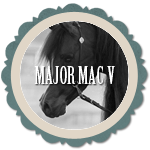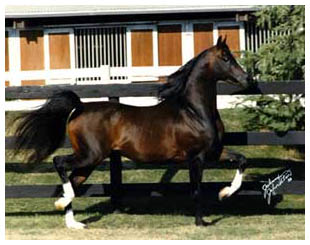 Huckleberry Bey++ in his famous trotting pose |
by Sheila Varian
Huckleberry Bey was foaled on March 19, 1976. We put him to sleep on December 27, 1992. During that time he was a vibrant, enthusiastic, cheerful horse who inherited the skill and coordination of a dancer with the disposition of a favorite child.
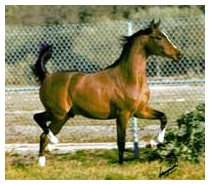 Huckleberry Bey++ as a yearling |
When Huckleberry Bey was foaled, he was darling - not a very stallion - like quality, but that's what he was. An endearing horse with such joyfulness about him. People used to ask me, "Why the name?" Remember Huck Finn floating down the river, chewing on a piece of grass and thinking up pranks to play on someone? Huckleberry Bey was the horse incarnate of Huckleberry Finn. As a young horse, he would get bored at the shows and want something to do ... and, of course, we'd all have to be in on the game. Huck would ever so carefully slip the metal pull end of a jacket zipper between his teeth and blissfully run the zipper up and down, opening and closing the jacket as you stood at attention, enjoying his delicacy in the matter. Huckleberry Bey played this game all his life. I never knew him to tear a jacket or break a zipper.
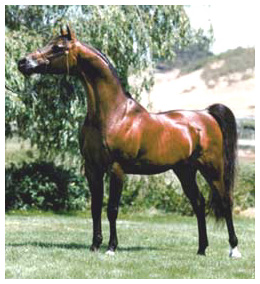 Bay-El-Bey, sire of Huckleberry Bey++ |
Huckleberry Bey, like his father and his father before him, would not touch, chew or tear up anything you put in his stall. You could sleep with him (which he happened to love), or put any horse - whether a mare in heat or another stallion - in the stall next to him with only bars between them and it was fine with him. That's what I expected, so that is what Huck accepted. Stories about Huckleberry Bey will be told as long as those of us who knew him are around to tell them, just as the stories about Bay-Abi and Bay El Bey are repeated and treasured.
Bay-Abi was a funny horse, full of zest, who tolerated my many mistakes and allowed the two of us to engage in the gentlest of activities, as well as the wildest kind of riding.
Bay El Bey was kingly from his first breath. Always gentle, always aristocratic. Huckleberry Bey was a perfect combination of the two - a sweet, vibrant, funny, aristocratic horse, who has been everything I could have wished for. When he was six months old, I realized I had another stallion to follow in line, and I believe he has since proven to be unique to our breed, creating his own type of Arabian horse that stirs the soul of anyone who's had the privilege of owning a daughter, son, grand get, or simply admiring him.
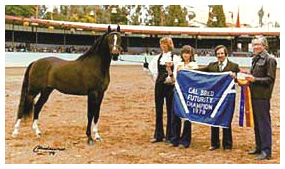 Huckleberry Bey++ winning the 1979 Cal-Bred Futurity Championship |
I remember so vividly showing Huckleberry Bey at the Cal-Bred Futurity Championships which he won unanimously, then going on to win the the U.S. National Futurities where the crowds got so excited and loud, Huckleberry Bey couldn't stand still. He was a beautiful National Reserve Champion - the epitome, in my mind, of the old Schreyer paintings - a horse with a high-set neck, fine skin and hair, just oozing Arabian type. He went on to garner the 1981 U.S. National Top Ten Stallion and the 1984 U.S. Reserve National English Pleasure Champion, as well as being a four-time U.S. Top Ten English Pleasure Champion.
Under saddle, Huckleberry Bey stopped people in their tracks. He drew a crowd just being bitted and longed, and won most of the major English pleasure classes in which he competed. "Why don't you make him a park horse?" I was asked. He probably could have been a good one, but his beauty was in the effortlessness and ease with which he carried himself in English pleasure. I never considered the change.
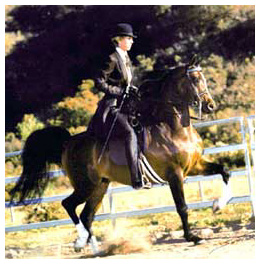 Sheila Varian riding Huckleberry Bey++ |
When I first rode Huckleberry Bey, I was overwhelmed. He scared me to death. I knew I was sitting on top of the most naturally talented horse I'd ever ridden, and I couldn't figure out what to teach him. What do you teach a horse that feels like he knows everything? Later I thought that I could have started at the beginning, but I wasn't smart enough to think of that at the time.
When Huckleberry Bey's show career was over, I took down his tail and told him to do whatever he wanted. Whenever the occasion presented itself to ride Huck, I was always astonished at how good he was. Funny how you can forget what a great horse feels like, and what a thrill it is to be reminded.
Huckleberry Bey had a good life. He never changed homes. He was always loved. He lived amidst other horses, played in a grass pasture, was extremely healthy, bred large numbers of mares, and was tended to with comfort in mind. He was allowed to do horse things - stand under a tree, have his tail as a fly swatter, be barefoot, not have the insides of his ears clipped, live in a clean area, have fresh water, eat a lot of carrots, intimidate Desperado V.
While he was living life at a horse level of enjoyment, we syndicated him, with me holding the controlling interest. I was willing to share ... a little bit.
Huckleberry Bey never let me or the syndicate members down. Each year, more and more Huckleberry Bey youngsters entered the show ring in across-the-board competition. From Park and English horses, to a stakes-winning race mare, to National Champion halter horses, to my ranch horse Lightly Bey V, Huckleberry Bey was a sire who truly proved the Arabian's versatility. He is still one of the leading sires of halter/performance horses. That is important to me for the Varian Arabian program: horses that can do something well and be beautiful doing it.
It was not until the late part of February 1992 did we have a clue something was amiss. As Don and I drove away from Scottsdale, we were on top of the world. Huckleberry Bey's youngsters had had an extremely strong showing in halter, and dominated the major performance classes. It was his time. However, when we got home, things were not okay. Huckleberry Bey felt fine, but his semen was overpowered by gel, which affected his fertility - something we had never seen in him before. Of course, we consulted our veterinarian and tried a number of different things. In May, test results confirmed Dr. Herthel's diagnosis: Huckleberry Bey had a pituitary tumor. A pituitary tumor! Usually seen in old horses, not in my young vital Huckleberry Bey! Not in Huckleberry Bey!
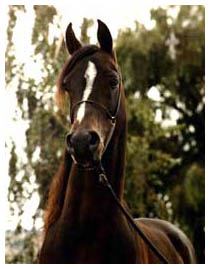 Huckleberry Bey++ in a quiet moment |
As syndicate manager, I had kept the syndicate apprised of the situation from the beginning, and certainly if ever a horse received the healing empathy of a group of people, Huck was in everyone's thoughts and had their blessings.
Huckleberry Bey has always been an expressive horse, and all of us at the ranch were very aware of how he was feeling. Huck didn't suffer as you would imagine with a brain tumor, but each change that we saw seemed always to be abrupt. He would be standing underneath the tree at the wrong time of the day, sleeping. Huck didn't stand under the tree sleeping. The ranch would be on edge. Dr. Herthel started him on an experimental drug, and 14 days later, Huckleberry Bey was his usual active self. The ranch was ecstatic. I suppose we thought we could keep him going with medication and care. Cushings disease, or a pituitary tumor, is not genetic, and no one knows why it affects aged horses, so we didn't know how much Huckleberry Bey's life would be shortened.
September came, and we were preparing for our annual ranch Extravaganza, a three-day activity during which we showcase our finest horses in a private treaty offering, provide educational activities, and highlight the VA breeding program in a finale presentation. Considering Huckleberry Bey's condition, we knew that this year we had to present all the stallions with their relatives - three living pedigrees, each with 12 to 17 horses ... owned by Varian Arabians ... standing in their place of history ... demonstrating how these bloodlines have been crisscrossed back and forth through generations of offspring. The thrill of seeing all these representatives of our lifelong effort was indescribable, and Huck was feeling on top of the world - he loved it all.
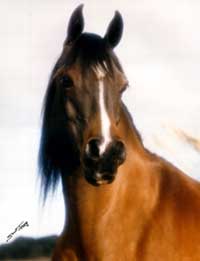 Huckleberry Bey's dam Taffona |
That weekend, however, was the highlight of the year for Huck. After that, the tumor began to show its effect more and more. We kept after it, but couldn't keep up. Huckleberry Bey continued to breed mares eagerly and cheerfully until early December. Suddenly, he began to lose weight, but was not unhappy. It was the end coming. On Sunday, December 27th, at 7:00 p.m., Dr. Herthel euthanized Huckleberry Bey. He is home, buried with his grandfather, Bay-Abi, Taffona, his sire Bay-Abi, his dam, *Naganka, his grandam, *Fortunka, *Bachantka, *Ostroga, Ronteza, Baychatka and Comment. Someone once said to me, "You have so many horses, Sheila, you're used to losing them." Do you get used to losing members of your family? I'd give anything to have that wonderful brown horse in his field again ... but it's not to be.
Huck, you're at home now on the hill at Varian Arabians. Our pastures are filled with Huckleberry Bey get, grand get and great-grand get. I have done some very interesting breeding back and forth within the lines. We are now into our eight-generation Varian-bred foal. Life moves on ... with our history ever present.
We have two historical videos of Huckleberry Bey++ available through our Boutique. The first is called "The Predictable Outcome - The Huckleberry Bey Story." The second one is called "Indian Summer - Dover Canyon." There are descriptions of each video on the Boutique page.
History of Bay El Bey++ <> Ronteza at the Cow Palace



